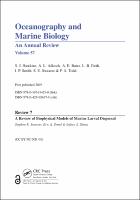Chapter 7 A Review of Biophysical Models of Marine Larval Dispersal
Proposal review
| dc.contributor.author | Swearer, Stephen E. | |
| dc.contributor.author | Treml, Eric A. | |
| dc.contributor.author | Shima, Jeffrey S. | |
| dc.date.accessioned | 2019-10-21 11:50:32 | |
| dc.date.accessioned | 2020-04-01T10:07:34Z | |
| dc.date.available | 2020-04-01T10:07:34Z | |
| dc.date.issued | 2019 | |
| dc.identifier | 1005391 | |
| dc.identifier | OCN: 1135848726 | en_US |
| dc.identifier.uri | http://library.oapen.org/handle/20.500.12657/24720 | |
| dc.description.abstract | Larval dispersal is arguably the most important but least understood demographic process in the sea. The likelihood of a larva dispersing from its birthplace to successfully recruit in another location is the culmination of many intrinsic and extrinsic factors that operate in early life. Empirically estimating the resulting population connectivity has been immensely difficult because of the challenges of studying and quantifying dispersal in the sea. Consequently, most estimates are based on predictions from biophysical models. Although there is a long history of dispersal modelling, there has been no comprehensive review of this literature. We conducted a systematic quantitative review to address the following questions: (1) Is there any bias in the distribution of research effort based on geographical or taxonomic coverage? (2) Are hydrodynamic models resolving ocean circulation at spatial scales (resolution and extent) relevant to the dispersal process under study? (3) Where, when and how many particles are being tracked, and is this effort sufficient to capture the spatiotemporal variability in dispersal? (4) How is biological and/or behavioural complexity incorporated into Lagrangian particle tracking models. (i.e. are key attributes of the dispersal process well captured.)? Our review confirms strong taxonomic and geographic biases in published work to date. We found that computational ‘effort’ (i.e. model resolution and particle number) has not kept pace with dramatic increases in computer processor speed. We also identified a number of shortcomings in the incorporation of biology, and behaviour specifically into models. Collectively, these findings highlight some important gaps and key areas for improvement of biophysical models that aspire to inform larval dispersal processes. In particular, we suggest the need for greater emphasis on validation of model assumptions, as well as testing of dispersal predictions with empirically derived data. | |
| dc.language | English | |
| dc.relation.ispartofseries | Oceanography and Marine Biology : An Annual Review | |
| dc.subject.classification | thema EDItEUR::P Mathematics and Science::PS Biology, life sciences | en_US |
| dc.subject.other | biophysical models | |
| dc.subject.other | marine larval dispersal | |
| dc.subject.other | demographic process | |
| dc.subject.other | sea | |
| dc.title | Chapter 7 A Review of Biophysical Models of Marine Larval Dispersal | |
| dc.type | chapter | |
| oapen.relation.isPublishedBy | 7b3c7b10-5b1e-40b3-860e-c6dd5197f0bb | |
| oapen.relation.isPartOfBook | 24ff3850-35d3-456a-a529-64c315cfe2b5 | |
| oapen.relation.isbn | 9780429026379 | |
| oapen.imprint | CRC Press | |
| oapen.pages | 34 | |
| oapen.remark.public | 3-8-2020 - No DOI registered in CrossRef for ISBN 97803671314150 | |
| oapen.identifier.ocn | 1135848726 | |
| peerreview.anonymity | Single-anonymised | |
| peerreview.id | bc80075c-96cc-4740-a9f3-a234bc2598f1 | |
| peerreview.open.review | No | |
| peerreview.publish.responsibility | Publisher | |
| peerreview.review.stage | Pre-publication | |
| peerreview.review.type | Proposal | |
| peerreview.reviewer.type | Internal editor | |
| peerreview.reviewer.type | External peer reviewer | |
| peerreview.title | Proposal review | |
| oapen.review.comments | Taylor & Francis open access titles are reviewed as a minimum at proposal stage by at least two external peer reviewers and an internal editor (additional reviews may be sought and additional content reviewed as required). |

